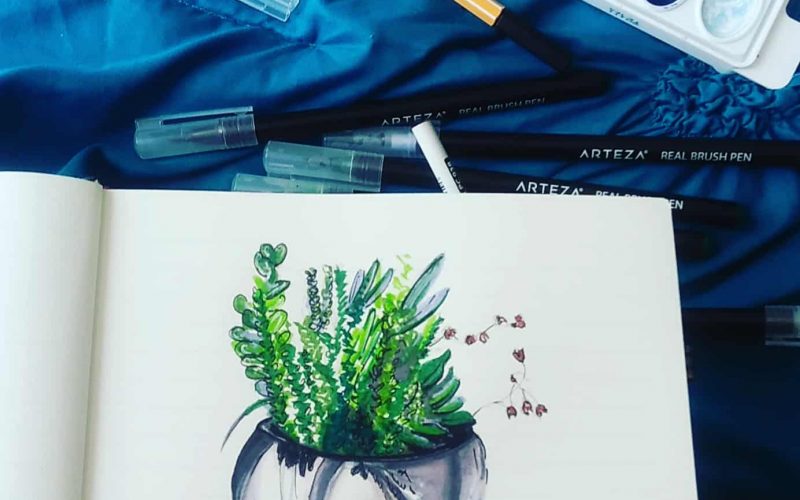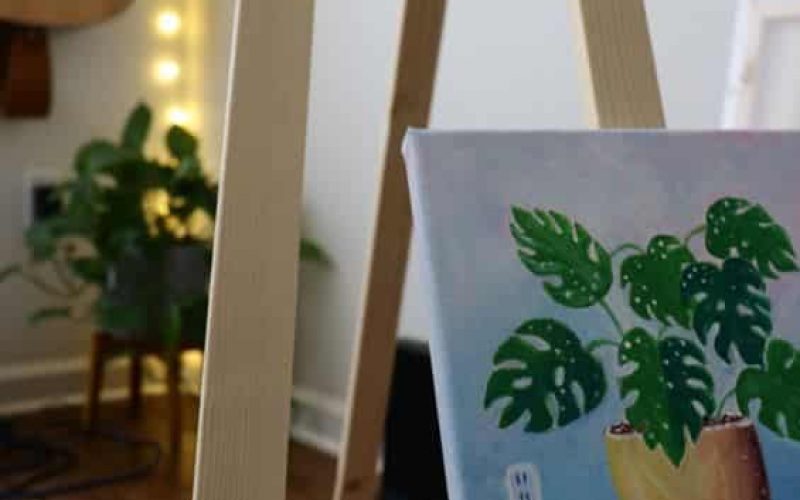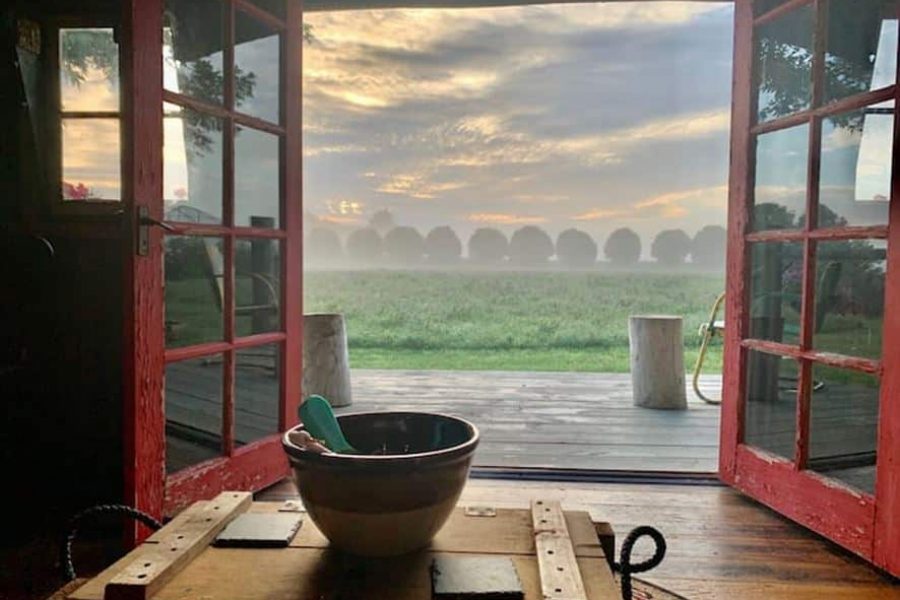A few weeks ago I took a pretty spontaneous trip to the Midwest to visit some old friends and get back to my roots. What I mean with getting back to my roots is visiting childhood places and reminiscing about old times. When I planned my little getaway trip, I found a cabin on a farm that looked charming, with its small deck and pitched roof. As soon as I saw it on Air BnB (https://www.airbnb.com/), I knew I had found the place for my stay. I arrived in Illinois after a few flight complications and was happy to finally make it to the cabin after a long and uneasy trip. The owners live in a house behind the cabin, and before my arrival they turned on all of the lights in the cozy sleeping quarters. I pulled up after the sun had gone down and crunched through the golden leaves to the front door of the cabin, warm light streaming through the glass doors and windows. I took the few steps up onto the wood deck and could feel the natural log walls welcome me. I opened the door and the scent of fresh trees filled my nose. I knew immediately that this was a special place. The owners placed a frame on the counter with a short description of the cabin. They used all natural and reclaimed wood to build the cabin. Old telephone poles made up the floor of the loft and previously discarded “treasures” were placed beautifully and with love around the cabin. I wondered why I had such a strong reaction and emotional attachment to this place I was going to spend a few nights in. Was it the cozy cabin vibe or the fact that I was in the middle of a field on a farm? Was it the connection to nature and the smell of fresh wood? Or maybe a mix of all of the above? All in all I knew there was something about the raw quality and authenticity of materials that drew me in and made me feel accepted (Figure 1).
Figure 1
Photo from the Cabin Looking Out Over the Fields
Note. The natural materials at the cabin had a strong impact on me and made me feel more connected to nature. (David, 2016)
So what is it about natural materials and interior design? Should we be using more of these nature-materials in our buildings?
First off, it may help to define what a natural material is. A natural or raw material is defined by Cambridge Dictionary as “found in nature and not involving anything made or done by people.” (dictionary.cambridge.org). Natural materials include wood, bamboo, wool, hemp, stone, copper, clay, and more (Figure 2).
Figure 2
Illustration of Natural Materials
Note. Natural materials include wood, wool and stone. (image by author)
Natural materials are good for our health and may have the ability to increase indoor air quality, reduce toxicity and passively regulate humidity in a building (MacDougal, 2008). Many synthetic building materials contain VOCs (volatile organic compounds) that are emitted into the air and add to indoor air pollution. Adhesives in flooring material can be a large source of VOCs that are harmful to human health. We spend about 90 percent of our time indoors, so we want to make sure we are breathing clean air. Chemicals in certain materials such as formaldehyde have been linked to increased risk of asthma, allergies and infection of the lungs. (Mitchell, 2013) Sick Building Syndrome is a term referring to occupants of a building feeling unwell as a result of spending time in the building. Poor indoor air quality can cause headaches, irritation of eyes, nose and throat, and skin problems as illustrated in Figure 3. (Burroughs & Shirley, 2011). If we use more natural materials sans the chemicals, binder, fillers and adhesives, indoor air quality may improve and so could our health.
Figure 3
Concentration of VOCs in Newly Renovated Buildings
Note. Discomfort and respiratory irritation increases with higher levels of VOCs. (image by author)
Imagine walking through a forest and breathing in the fresh scent of pine. Compare that feeling to sitting in a building with chemicals emanating from the synthetic carpet and paint on the walls. In Japan there is actually a term for taking a walk in a forest to reduce stress. It is called shinrin-yoku, which means “taking in the atmosphere of the forest.” In a study at Japan’s Kyoto University, 498 volunteers participated and took two 15-minute walks in a forest one day, compared to a day when they didn’t walk. The study found that hostility and depression scores decreased after walking in the forest (Morita et al., 2007). This resonates with me because when I stepped into the little cabin on the farm in Illinois and smelled the scent of trees I immediately felt relaxed and at ease. Researchers discovered that pine bark and needles contain Vitamin C. Testing French Coastal Pines, they found that the trees are full of beneficial antioxidant compounds called flavonols and bioflavonoids (Altshul, 2012).
Similar to the study at the Kyoto University, studies in Norway, Japan, Canada and Austria show that being around wood reduces stress. Researchers discovered that wooden structures cause a drop in blood pressure and pulse and have a calming effect. If we spend more time in environments with wood, our health and well-being of mind and body can improve. Even just touching a wooden surface makes people feel at ease and close to nature, according to observations made in research. A further study showed that stress levels were lowest among participants who spent time in a room with wooden furniture. A couple of reasons for this could be the softness of wood, improved air quality and acoustics, and the fact that wood makes us feel close to nature (Wallenius, 2014) (Figure 4).
Figure 4
Photo of Wood Materials Used at the Cabin on the Farm
Note. This photo was taken in the bedroom of the cabin. It is an example of how natural wood can be used in interiors, so we are exposed to it and can touch it. (image by author)
The blog Authentic Interiors mentions rattan, plywood, jute, sisal, hemp, and terracotta as other natural materials (Sniraite, 2019). The author of the blog refers to these materials as humble, which sparks an image in my mind of a certain softness, while still being strong and powerful. I like the idea of using natural and humble materials in spaces we inhabit. I think it is a way to feel more in tune with nature and get back to our roots. A way to ground ourselves and remember what is real, true and authentic. I really enjoyed my time at the cabin and hope I will be back someday. (Figure 5)
Figure 5
Ryan’s Place Cabin in Yuton, Illinois
Note. I felt inspired at the cabin in the Midwest and decided to do a little quick sketch for the owners, which is now sitting in their kitchen. (image by author)
References
Altshul, S. (2012, December 5). The healing power of pine. Health. https://www.health.com/mind-body/the-healing-power-of-pine
David (2016). Ryan’s Place Cabin. Air BnB. https://www.airbnb.com/rooms/36468102?source_impression_id=p3_1607974289_xEv4vdtlkVr6IkoU&guests=1&adults=1
MacDougal, C. (2008). Natural building materials in mainstream construction: Lessons from the U. K. Journal of Green Building, 3(3), 1–14. https://doi.org/10.3992/jgb.3.3.1
Mitchell, B. (2013, September 1). Building Materials Can Be a Major Source of Indoor Air Pollution. OH&S Occupational Health and Safety. https://ohsonline.com/Articles/2013/09/01/Building-Materials-Can-Be-a-Major-Source-of-Indoor-Air-Pollution.aspx?Page=3
Morita, E., Fukuda, S., Nagano, J., Hamajima, N., Yamamoto, H., Iwai, Y., Nakashima, T., Ohira, H., & Shirakawa, T. (2007). Psychological effects of forest environments on healthy adults: Shinrin-yoku (forest-air bathing, walking) as a possible method of stress reduction. Public health, 121(1), 54–63. https://doi.org/10.1016/j.puhe.2006.05.024
Sniraite, A. (2019, June 6). Interior design trends 2020 #1: Humble materials. Authentic Interior.
Wallenius, M. (2014, May 14). Wood construction reduces stress and offers a healthy living environment.
WoodProducts. https://www.woodproducts.fi/articles/wood-construction-reduces-stress-and-offers-a-healthy-living-environment












